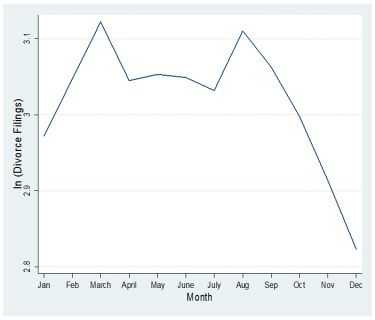 It is commonly believed that January is “divorce month,” but a new study indicates March and August are the months that receive the most divorce filings.
It is commonly believed that January is “divorce month,” but a new study indicates March and August are the months that receive the most divorce filings.
University of Washington sociology professor Julie Brines and doctoral candidate Brian Serafini recently analyzed the last 15 years of divorce filings in Washington and found what is believed to be the first quantitative evidence of a seasonal, biannual pattern of divorce filings.
Their working paper was recently presented at the American Sociological Association’s annual meeting in Seattle.
Brines suggested the reason for the pattern might have something to do with the sentiment that holidays and vacations are considered culturally sacred. It’s common for couples to try to stick it out and delay a divorce until after the holidays, and vacations are sometimes used as a last-ditch effort to try to find a renewed spark in a relationship.
“People tend to face the holidays with rising expectations, despite what disappointments they might have had in years past,” Brines said in a press release. “They represent periods in the year when there’s the anticipation or the opportunity for a new beginning, a new start, something different, a transition into a new period of life. It’s like an optimism cycle, in a sense.

“They’re very symbolically charged moments in time for the culture.”
While some couples might try to use Christmas or a trip to the beach as an event to reinvigorate their relationships, often the stress of these events does more harm than good.
“These rituals and transitions can be stress-inducing, and thus may intensify dissatisfaction or discord past a breaking point in some couples,” the authors write.
When those seasons pass and couples still feel dissatisfied with their marriage, that’s when they decide divorce is inevitable, so the logic goes. After that renewed optimism dissipates, many couples find themselves even more unhappy than before in what the authors describe as the “broken promise” theory.
Rather than immediately filing in January after the holidays, couples take some time to organize their finances and find an attorney, Brines speculates. The start of the school year in August could also speed the timing for couples with children.
The authors noted these patterns closely follow trends in the suicide rate, which peaks in the spring. Experts have theorized that longer days motivate people to act and make changes in their lives, and Brines guesses that similar factors could be in play with divorce.
While the research is certainly interesting, it has yet to be peer-reviewed.
The researchers are now trying to determine whether similar filing patterns exist in other states. Thus far, they’ve discovered similar trends in Ohio, Minnesota, Florida, and Arizona, which “have similar divorce laws as Washington but differ in demographics and economic conditions.”

